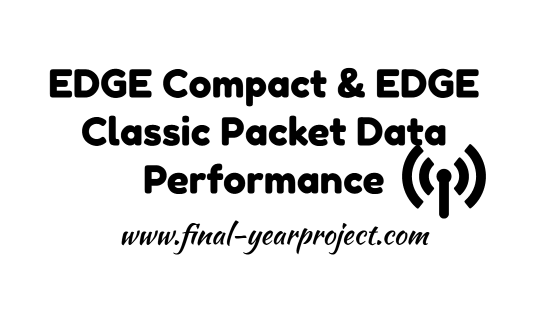In this paper we talk the two stages of EDGE, classic and compact. We start our dialogue with the link model and incremental tendency strategies. Secondly we pass for discussing area classic and compact systems and their deployment eventualities, accompanied with the aid of downlink performance contrast and some MAC layer enhancement strategies which improve the performance.
EDGE Compact uses discontinuous transmission based on a 52 -multiframe2 (a multi-frame consisting of 52 frames) and designates different time slots and frames for sending control information. In blocks (blocks are non-overlapping and are each comprised of timeslots from the same timeslot number of 4 successive frames) when a sector belonging to one of the time-groups transmits or receives common control signaling (serving time-group), the sectors belonging to other (non-serving time-groups) are idle.
The TDMA and GSM systems have chosen the same EDGE radio-access and GPRS packet-switched core network technologies to provide third-generation services in existing spectrum. Accordingly, a common access for data services can be offered to more than 370 million mobile subscribers. EDGE can be deployed in two modes in TDMA systems: Classic and COMPACT. The Classic system requires only minimum extension to GSM EDGE and uses standard GSM/GPRS control channels, which facilitates global roaming.
Recommended Project: Wireless based Tsunami & Earthquake Warning System
The COMPACT system introduces a novel control channel configuration, synchronized base stations, and discontinuous transmission on the first carriers, which facilitates the deployment of EDGE control channels in a 1/3 frequency-reuse pattern. Thus, the initial deployment of COMPACT requires only a very limited amount of spectrum —600 kHz plus guard bands. With fractional loading, excellent spectral efficiency can be attained with data rates of up to 384 kbit/s.
COMPACT thus supports UWCC requirements for third-generation services with high spectral efficiency and initial deployment within less than 1 MHz of spectrum.
DOWNLOAD
Advertisements:-





![Final Year Projects for CSE [2023]](https://blogger.googleusercontent.com/img/b/R29vZ2xl/AVvXsEicwsr89FawhHP1j_XcxTGTU5DxuevpZUQTgFlo_rzjh2YOVGC68ii16T6I7pLcUrR9mu9pVkGsEe_eXBWZhf3fBL-MyLFmw8l0BhRYNOEchX5TlIPCvHoiED-Ix_ZpIbH7T7bklprg5YlabbOX6fPz1Y5-Q4TF7i-MLIEAfbaSjvsJmbnTr91t8i_7Ag/s72-c/final%20year%20projects%20for%20cse.png)




No comments:
Post a Comment